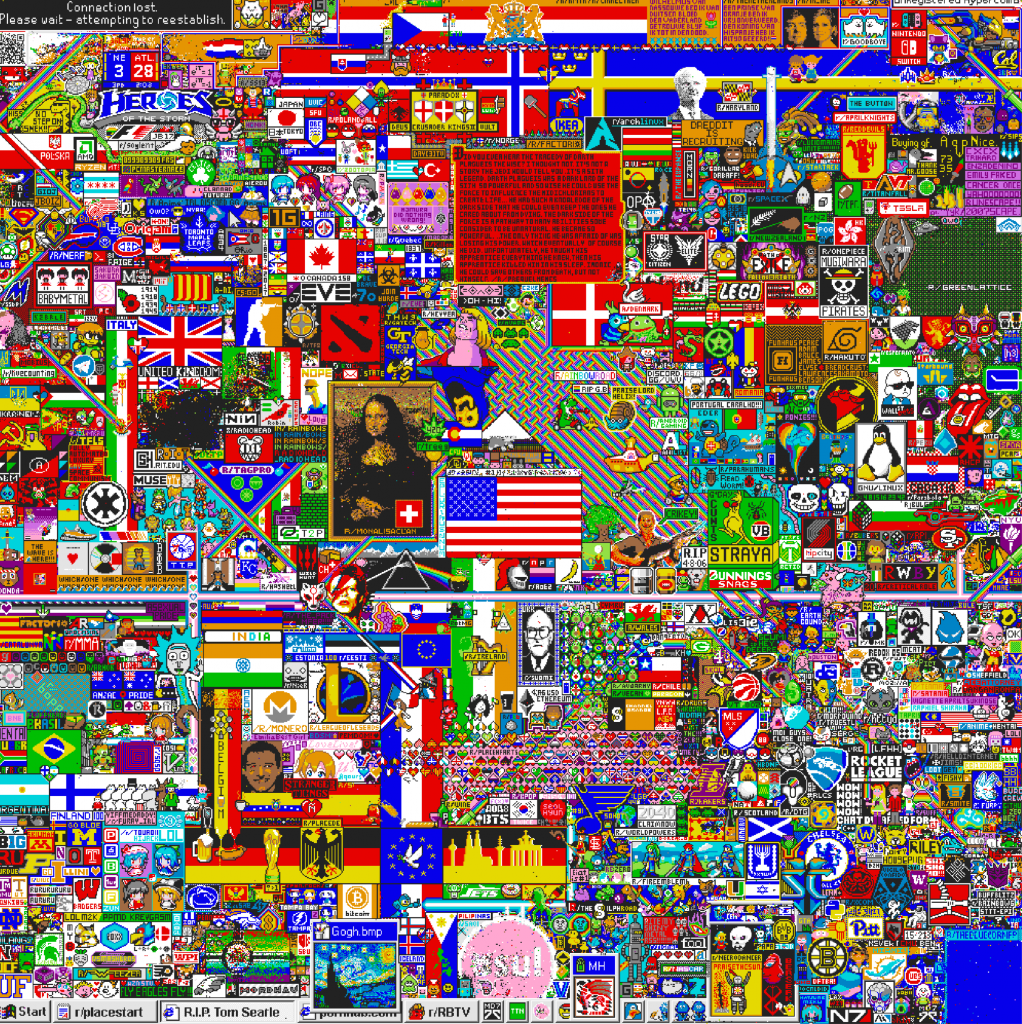
Whenever I hear the term ‘social experiment’ these days, my mind immediately goes to this awful trend of various internet personalities doing increasingly rude things to random people in public and using the excuse of ‘it’s a social experiment!’ to justify their unacceptable behavior. This is of course a replacement for the equally loathsome ‘it’s just a prank. bro!’ argument. However! Despite this being my immediate mental image upon hearing that term, I am happy to report that there are in fact some positive, and even fun examples of social experiments. The one that I would like to highlight here, is Reddit’s ‘Place’ experiment from 2017.
‘Place’, or r/Place, was originally started on April Fool’s Day, in 2017. It ended 3 days later, having become famous and widely praised. Despite the day on which this particular event/experiment launched, I could hardly describe it as a joke. Instead, it would be more accurate to describe it as a co-operative artwork, with the entire Reddit community being able to participate in its creation. For those who are unaware of what r/Place was, it was essentially a blank field of one thousand by one thousand pixels (a million pixels in total), upon which users could replace individual pixels with one of sixteen available colors. Imagine working on a group document in something like Google Docs, except instead of it being a text document, it was a pixel art canvas. To extend that analogy a little bit further, imagine that instead of working on said document with perhaps five people in total, you were working on it with more than a million others.
You can imagine the sort of chaos that was, and perhaps that chaos was entirely the point. To prevent it from being too ridiculous to handle however, there was a ‘cooldown’ period after placing a pixel, to prevent users from rapidly changing large parts of the canvas. This cooldown timer lasted anywhere from five to twenty minutes, appearing to randomly change for each user.
The initial filling up of the canvas lacked any form of serious organization, save for a few users attempting to construct small pieces of pixel art, before their work was ruined by other users changing their pixels to something else. It was a colorful mess, a static noise pattern in sixteen different colors. The first notable creations were the ‘rainbow road’, which over time would keep expanding and maintain its place on the canvas, traveling all over Place, as well as the ‘Blue Corner’ in the bottom right. The latter had simple goal, which it stuck by throughout the entire experiment; make a solid blue corner.
It was at this point that various communities from other subreddits got involved, and some were even created specifically for r/Place. They started organizing, and made coordinated efforts to create particular images. Flags of various countries were the first to appear after this, along with certain simple internet memes. Over time however, Place became filled with ever more intricate drawings, showing off video game logos, album art, classical paintings such as da Vinci’s Mona Lisa and van Gogh’s Starry Night, and many more things. Some communities even constructed entire paragraphs of text, such as parts of the Dutch anthem or the ‘Darth Plagueis The Wise’ meme.
What I find particularly interesting about this, is how the longer r/Place went on, the less chaotic it became. Sure, the canvas ended up a mess of logos, memes, flags, and art, but this was a decidedly less chaotic outcome than the original nonsensical mess of colors. It appears that people got more and more attached to their creations over time, and helping their community achieve certain goals became more important than randomly destroying the works of others. This does not mean that there were no attacks and takeovers however, it just so happened that said attacks and takeovers were coordinated, and happened suddenly. Retaliations for such events were also commonplace, where one community would discover which community was responsible for the destruction of their art, and would counterattack by destroying or replacing that community’s art. Some have described r/Place as a benign microcosm of society, and I would agree with this stance. It was a fun example of the creation and defense of culture and finding one’s place in the world, all happening in a decidedly silly setting. I also think that it is a nice reflection of what internet culture was like in 2017. Which memes were topical and popular, what people’s stances on various things were, etc.
Place was archived on the 19th of April, 2017. I would highly suggest watching this time-lapse, as it is only a few minutes long, but feels as if it could be re-watched endlessly by choosing to focus your attention on different things each time. I hope you’ll find it as fascinating as I have.


Hey Connor,
that’s a really intresting experiment you are talking about!
To be honest, I haven’t heard about it before.
I think it is a really nice reflection of how communities work and how a structure and rules are formed.
There are many experiments that resemble this one and explore how large amount of people organize themselves and how they react to decisions of others.
Like in a real society, it needs some time to establish structure in the chaos and to adapt to possible actions of the others.
I would really like to see an experiment like that again in a few years to find out if the behavior of people changes over time.
Thanks for taking the time to reply. I agree that it is a nice reflection of the evolution of a community, and I would also love to see a similar experiment in the future!